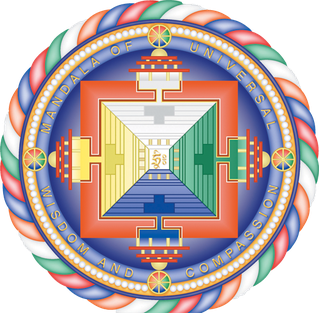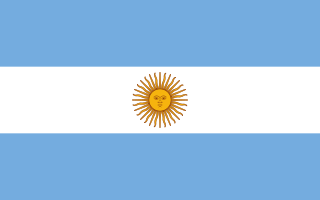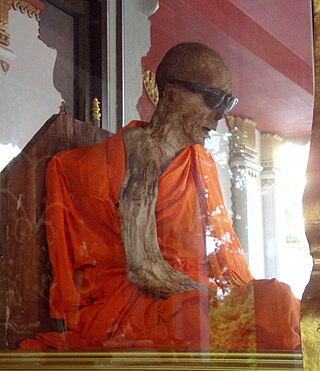Related Research Articles
Buddhism in the West broadly encompasses the knowledge and practice of Buddhism outside of Asia in the Western world. Occasional intersections between Western civilization and the Buddhist world have been occurring for thousands of years. The first Westerners to become Buddhists were Greeks who settled in Bactria and India during the Hellenistic period. They became influential figures during the reigns of the Indo-Greek kings, whose patronage of Buddhism led to the emergence of Greco-Buddhism and Greco-Buddhist art. There was little contact between the Western and Buddhist cultures during most of the Middle Ages but the early modern rise of global trade and mercantilism, improved navigation technology and the European colonization of Asian Buddhist countries led to increased knowledge of Buddhism among Westerners. This increased contact led to various responses from Buddhists and Westerners throughout the modern era. These include religious proselytism, religious polemics and debates, Buddhist modernism, Western convert Buddhists and the rise of Buddhist studies in Western academia. During the 20th century, there was a growth in Western Buddhism due to various factors such as immigration, globalization, the decline of Christianity and increased interest among Westerners. The various schools of Buddhism are now established in all major Western countries making up a small minority in the United States, Europe, Australia and New Zealand.

Geshe Kelsang Gyatso was a Buddhist monk, meditation teacher, scholar, and author. He was the founder and spiritual director of the New Kadampa Tradition-International Kadampa Buddhist Union (NKT-IKBU), a registered non-profit, modern Buddhist organization that came out of the Gelugpa school/lineage. They have 1,300 centres around the world, including temples, city temples and retreat centres that offer an accessible approach to ancient wisdom.
The history of Buddhism can be traced back to the 5th century BCE. Buddhism arose in Ancient India, in and around the ancient Kingdom of Magadha, and is based on the teachings of the renunciate Siddhārtha Gautama. The religion evolved as it spread from the northeastern region of the Indian subcontinent throughout Central, East, and Southeast Asia. At one time or another, it influenced most of Asia.
Buddhism is a legally recognized religion in Austria. Although still small in absolute numbers, Buddhism in Austria enjoys widespread acceptance. A majority of Buddhists in the country are Austrian nationals, while a considerable number of them are foreign nationals.

The term American Buddhism can be used to describe all Buddhist groups within the United States, including Asian-American Buddhists born into the faith, who comprise the largest percentage of Buddhists in the country.

The New Kadampa Tradition – International Kadampa Buddhist Union (NKT—IKBU) is a global Buddhist new religious movement founded by Kelsang Gyatso in England in 1991. In 2003 the words "International Kadampa Buddhist Union" (IKBU) were added to the original name "New Kadampa Tradition". The NKT-IKBU is an international organisation registered in England as a charitable, or non-profit, company. It currently lists more than 200 centres and around 900 branch classes/study groups in 40 countries. The BBC describe the New Kadampa Tradition as "one of the major Buddhist schools in the UK, founded by the Tibetan-born Geshe Kelsang Gyatso."

The Foundation for the Preservation of the Mahayana Tradition (FPMT) was founded in 1975 by Gelugpa Lamas Thubten Yeshe and Thubten Zopa Rinpoche, who began teaching Tibetan Buddhism to Western students in Nepal. The FPMT has grown to encompass over 138 dharma centers, projects, and services in 34 countries. Lama Yeshe led the organization until his death in 1984, followed by Lama Zopa until his death in 2023. The FPMT is now without a spiritual director; meetings on the organization's structure and future are planned.

Diamond Way Buddhism is a lay organization within the Karma Kagyu school of Tibetan Buddhism. The first Diamond Way Buddhist center was founded in 1972 by Hannah Nydahl and Ole Nydahl in Copenhagen under the guidance of Rangjung Rigpe Dorje, 16th Karmapa. Today there are approximately 650 centers worldwide, directed by Ole Nydahl under the guidance of Trinley Thaye Dorje, one of two claimants to the title of the 17th Karmapa. Buddhist teachers such as Sherab Gyaltsen Rinpoche, Lama Jigme Rinpoche and Nedo Kuchung Rinpoche visit Diamond Way Buddhism centers and large meditation courses.

Buddhism is a minority religion in Argentina, where, in addition to the majority of the Christian population, the rate of self-professed Buddhists is about 0.5%.

Although there was regular contact between practising Buddhists and Europeans in antiquity the former had little direct impact. In the latter half of the 19th century, Buddhism came to the attention of Western intellectuals and during the course of the following century the number of adherents has grown. There are now between 1 and 4 million Buddhists in Europe, the majority in Italy, Germany, Hungary, France and the United Kingdom.

Nan Hua Temple is the largest Buddhist temple and seminary in Africa, and is situated in the Cultura Park suburb of Bronkhorstspruit, South Africa. It is the African headquarters of the Fo Guang Shan Order, covering over 600 acres (2.4 km2). Fo Guang Shan was established in 1967 by Venerable Master Hsing Yun, and is a Mahayana Chinese Buddhism monastic order. The Temple, like its mother order in Taiwan, follows the Linji Chan school of Buddhism as well as the Pure Land School.

Sokushinbutsu are a kind of Buddhist mummy. In Japan the term refers to the practice of Buddhist monks observing asceticism to the point of death and entering mummification while alive. Although mummified monks are seen in a number of Buddhist countries, especially in South Asia where monks are mummified after dying of natural causes, it is only in Japan that monks are believed to have induced their own death by starvation.

Jetsunma Ahkon Lhamo is a tulku within the Palyul lineage of the Nyingma tradition of Tibetan Buddhism. She gained international attention when she, a western woman, was enthroned as a reincarnated lama. Since the mid-1980's she has served as spiritual director for Kunzang Odsal Palyul Changchub Choling, a Buddhist center in Poolesville, Maryland, which includes a large community of western monks and nuns. She also founded a center in Sedona, Arizona, U.S.A., and has small communities of students in California and Australia. Ahkon Lhamo has been described by her teachers, Tibetan lamas Penor Rinpoche, Gyatrul Rinpoche, as well as others such as Jigme Phuntsok, as a dakini or female wisdom being.

The Venerable Samu Sunim, born Sam-Woo Kim, was a Korean Seon sunim previously of the Jogye Order. He claimed to have received Dharma transmission from Zen Master Weolha Sunim in 1983. He taught primarily in Canada and the United States, having opened centers in Toronto, New York City, Ann Arbor, Michigan and Chicago, Illinois as well as Mexico City.
Buddhism is a small minority religion in the Netherlands, but it has shown rapid growth in recent years. As of the 2006 estimate, 170,000 Dutch people identified their religion as Buddhist.

Buddhism in Scotland is a relatively recent phenomenon. In Scotland Buddhists represent 0.24% of the population or around 13,000 people.
The Tibetan Aid Project (TAP) is an operation of the Tibetan Nyingma Relief Foundation. TAP was founded in 1969 by Tarthang Tulku—a leading Tibetan master and teacher—to support the efforts of Tibetans to survive in exile and re-establish their cultural heritage. It is a 501 c (3) non-profit organization that primarily focuses on raising funds for the production, shipment and distribution of sacred texts, art and prayer wheels for the World Peace Ceremony in Bodh Gaya, India.
Buddhism in Hungary has existed since 1951 when Ernő Hetényi founded the Buddhist Mission in Germany, as a member of the Arya Maitreya Mandala Buddhist order. However, the first Buddhist community had been founded in the 1890s in Máramarossziget. József Hollósy took refuge and wrote Buddhista Kátét (1893) — the first Buddhist catechism in Hungarian. According to this, the Dharma has been present in Hungary for more than a century. In 1933 the Hungarian philologist and Orientalist — author of the first Tibetan-English dictionary and grammar book Sándor Kőrösi Csoma — was recognised as a bodhisattva in Japan. In Hungary József Hollósy is regarded as the second bodhisattva.
References
- 1 2 3 4 5 6 7 8 9 10 11 12 13 Clasquin, Michel (2004). "Ixopo: The Evolution of a South African Buddhist Centre". Journal for the Study of Religion. 17 (1): 45–65. doi:10.4314/jsr.v17i1.6115. hdl: 10500/4721 . JSTOR 24764298.
- 1 2 3 "An ubuntu Buddhist in Ixopo". brandsouthafrica.com. brandsouthafrica.com. 12 December 2006. Retrieved 12 December 2019.
- 1 2 3 "THE RISE OF BUDDHISM IN SOUTH AFRICA, RETREAT CENTRE IXOPO AND ITS STUPA". steemit.com. steemit. 2018. Retrieved 1 January 2020.
- 1 2 3 Hennig, Wanda (28 June 2019). "Retreating to flavour and mindfulness". Daily Maverick. Retrieved 28 June 2019.
- ↑ Fabricius, Peter (3 January 2011). "Zen Buddhism sings softly in the hills". buddhistchannel.tv. buddhistchannel.tv. Retrieved 3 January 2020.
- 1 2 PATRICK, ALEX (5 August 2018). "One of the world's 10 best meditation retreats is in KwaZulu-Natal". Sunday Times. Retrieved 5 August 2019.
- ↑ Weber, Rebecca L. (15 June 2017). "10 of the world's best meditation retreats". CNN. Retrieved 15 June 2019.
- ↑ "Representative Ngodup Dorjee Talks Tibet at Buddhist Retreat Centre, Ixopo". tibet.net. 22 June 2018. Retrieved 22 June 2018.
- ↑ "30 Relaxing Meditation Retreats Around the World". U.S. News & World Report. Washington DC. 5 August 2018. Retrieved 5 August 2019.
- ↑ "Find your freedom at the Buddhist Retreat Centre". famouspublishing.co.za. Famous Publishing. 5 June 2017. Retrieved 5 June 2017.
- ↑ "FINDING SOLITUDE – THE BUDDHIST RETREAT CENTRE, IXOPO, SOUTH AFRICA". DREAMING IN ARABIC ADVENTURES IN THE UNITED ARAB EMIRATES & BEYOND. dreaminginarabic.wordpress.com. 19 April 2017. Retrieved 19 April 2019.
- 1 2 HENNIG, WANDA (19 May 2011). "Cake dharma". IOL. IOL. Retrieved 19 May 2019.
- 1 2 "Plentiful". jacana.co.za. Jacana Media. Retrieved 28 June 2019.